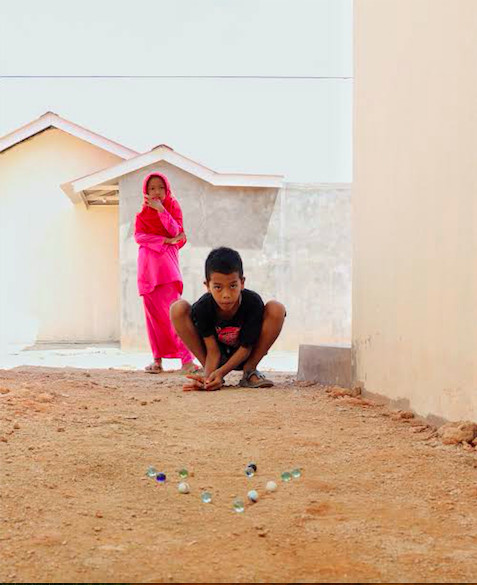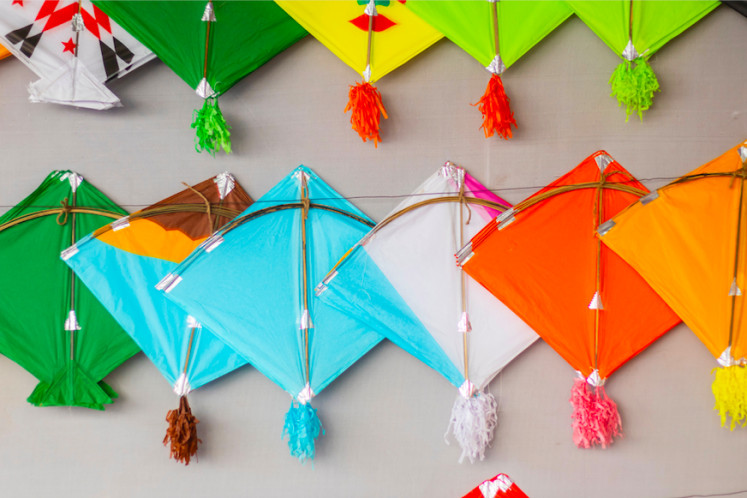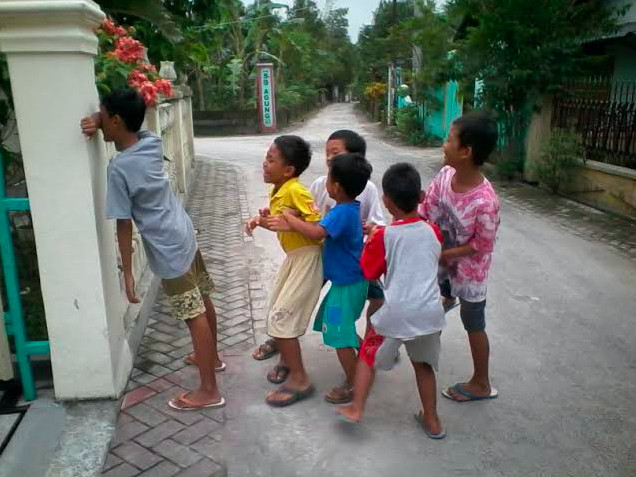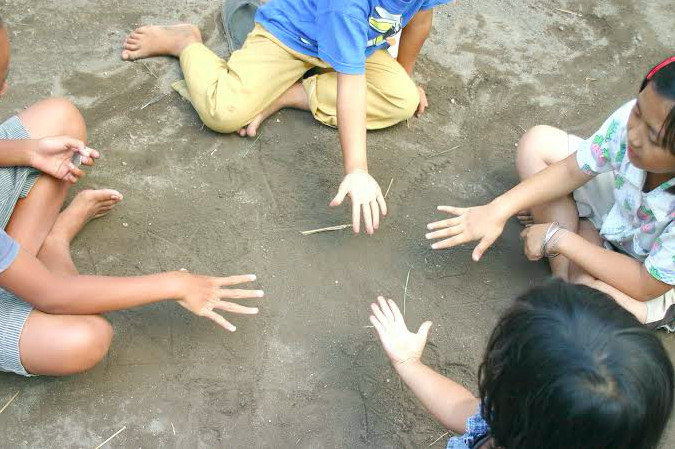Popular Reads
Top Results
Can't find what you're looking for?
View all search resultsPopular Reads
Top Results
Can't find what you're looking for?
View all search resultsTwenties: Reminiscing the dying art of Indonesian traditional children's games
Indonesian traditional children's games hold special meanings, traditions and origins associated with each of their respective cultures. Here are 20 traditional Indonesian children's games for a nostalgic journey.
Change text size
Gift Premium Articles
to Anyone
'Twenties' is a column in which we give our top 20 list of anything and everything of interest, from food and history to pop culture, lifestyle and more.
More than just entertainment, Indonesian traditional children's games hold special meanings, traditions and origins associated with each of their respective cultures. Here are 20 traditional Indonesian children's games to start your cultural and nostalgic journey.
Gundu
Gundu is a popular traditional children's game where the players need to flick a small ball called kelereng or gundu (marbles). Gundu is preferably played on a flat surface.
The history of this popular game is said to have started with the ancient Egyptian civilization in 3000 BC when gundu were made of rocks or clay. In the 12th century, the game began to gain popularity in France and wider areas, including the Netherlands, where marbles were known as knikkers. This probably was how Indonesians came to know gundu, while Indonesia was under Dutch colonial rule.
Adu Muncang
Adu muncang is a traditional game that originated in Garut, West Java. Using a similar method to playing gundu, adu means to "fight" or "compete", while muncang means "candlenut". Thus, adu muncang means competing with the strength of the candlenut.
The precise date of the game's first appearance is unknown. However, it is said that during the Sunda Kingdom era, adu muncang was used as a tool to measure an individual's spiritual power. In modern Garut, however, adu muncang is no longer used to assess spiritual strength but rather as a gambling game.
Layangan
Layangan, layang-layang, (flying kites) is a traditional game that originated in China around 2500 BC and has since been a culturally important traditional game in Indonesia. Beyond child's play, layangan also holds other functions, such as a sacred tool to protect God's throne in Bali, a tool to repel agricultural pests in Java and a hunting tool in Lampung.
Layangan is mostly played by children during their leisure time. This game also helps children to be more focused, train their eye-hand coordination and enhance gross motor skills.
Fly up: In certain areas in Indonesia, kites also have cultural meanings. (Unsplash/VD Photography) (Unsplash/VD Photography)Gasing
Gasing is a traditional spinning top game made from bamboo that also originated in China. Although the history of its spread to Indonesia is unknown, gasing was found in the Tujuh Islands of Natuna, Riau Islands, before the Dutch came to the archipelago.
In the past, gasing was used in a post-harvest ritual. Locals believed that the sound of the gasing – due to the shift of air movement through the hole on the side of its bamboo tube – could call the Goddess of Rice for a better harvest.
Going round and round: 'Gasing' or a spinning toy was said to be found in the Tujuh Islands (Natuna), Riau Islands, before the Dutch colonization era.(Unsplash/Giovanni Cordioli) (Unsplash/Giovanni Cordioli)Lompat Tali
Known to have its root in West Sumatra, lompat tali (jump rope) was brought by European colonizers to Indonesia. During that time, Dutch children would play the game with three people: two persons holding the rope and one jumping over it.
Lompat tali symbolizes an ever-growing challenge in life, one after the other, where the swinging rope resembles life's obstacles that must always be passed.
Bekel
Bekel originally developed in East Java, influenced by Dutch culture. The word bekel itself was derived from the Dutch word "bikkelspel", meaning "knucklebone game".
The game is carried out by collecting bekel seeds after the bekel ball is tossed into the air, followed by taking the ball back after it bounces once. The seeds are usually seashells, sometimes made of brass or plastic, while the ball is a ping-pong-sized ball made of rubber.
Congklak
Congklak, also known as dakon, is a traditional game from Malaysia that was brought to Indonesia by Arab traders, according to historians. The game symbolizes people who live a certain number of days in a week and that each day spent has an effect on days yet to come.
Congklak is played by two players, and each of them needs to fill the holes in the board with seven congklak pieces. After filling the holes, players will then take turns moving the pieces clockwise one by one until all pieces in their hands are placed on the board.
Balap Karung
The balap karung (sack race) is now one of the must-play games during Indonesia's Independence Day. It has simple rules. Players put their lower bodies into a thick sack made of gunny and race to reach the finish line by jumping.
Originally, balap karung was brought by Dutch missionaries to schools and other Dutch-made institutions. Afterward, Indonesians started to adapt to the game, and they have continued to play it until today.
Bentengan
Bentengan is a popular traditional game inspired by survival strategies used by Indonesians during the colonial era, where they used a benteng (fortress) to protect themselves from attacks.
The goal of the game is to take control of the opposing team's fortress by tagging the opposing team's members. The tagged players will then become the prisoners of the opposing team's players. The winning team is the one that manages to tag all of the opposing team's players and touch their fortress.
Egrang
Egrang is a traditional game influenced by Chinese culture that teaches children the philosophical value of future opportunities. It is said that egrang took its root in Lampung.
Known as terompah pancung in Lampung, egrang is played by standing on a pair of tall bamboo shoots, and the players are required to maintain their balance as they walk with the long bamboo legs.
Not just for fun: By playing egrang, the players can test their physical balance. (Wikimedia Commons/Masmusdjeprat) (Wikimedia Commons/Masmusdjeprat)Engklek
In Javanese, engklek means "walking or jumping on one leg". Similar to hopscotch, engklek, sometimes known as taplak, is played by jumping on squares drawn on the ground from one to another without falling. This game symbolizes the eagerness, tenacity and effort needed to reach a certain goal.
Engklek players will need to throw the gaco – a flat rock used as the players' piece – into the first square and jump with one leg from one square to the other, except for the square with the gaco. After the player reaches the last square, they need to return to their starting position, jumping with one leg while taking the gaco.
Gobak Sodor
Originating from Central Java, gobak sodor is a game inspired by an activity done by soldiers to train or improve their skills in fighting during the war. The game was called sodoran at the time. Gobak sodor is believed to hold several values such as happiness, sportsmanship, fighting spirit, social skills, agility, strategy and leadership.
Gobak sodor is played by two teams, each consisting of three people. The teams are divided into defenders and attackers. The defender team needs to prevent the attacker from reaching the finish line.
Kucing-kucingan
Kucing-kucingan is one of the most popular traditional games that has existed since 1913 in Java. The whole game is about a chase between the kucing (cat) and the mouse—with a circle formed to serve as the mouse's safe zone from the cat.
This game requires several players: One player as the cat, one as the mouse, and others to guard the mice. The game helps children to learn the essence of teamwork, trust-building, accuracy and balance.
Lenggang Rotan
Lenggang rotan (rattan dancing) is a local take on hula hooping, where rotan refers to the material used to make the hoops.
The hoops were usually made of metal, bamboo, wood, rattan, grass or vines. To play lenggang rotan, players need to move the hoop around their body using their lower abdomen. When it is played as a contest, the one who drops their hoop first loses the game.
Petak Umpet
Petak umpet, or hide-and-seek, has been a staple children's game in every era. Many believe that the game originated in Greece because Julius Pollux, a Greek writer, described it in his works two centuries before the common era.
This game can be played with as many players as possible, with one player as the seeker. The seeker will then count to 10, and the rest of the players will have to look for places to hide. After that, it will be the seeker's turn to find the players in their hiding places.
Find me: 'Petak umpet' is a popular game since it requires practically no tool. (Wikimedia Commons/Nicco Blue) (Wikimedia Commons/Nicco Blue)Hom-Pim-Pa
In Indonesia, hom-pim-pa is known as a starter to play a certain game rather than being a standalone game. This activity is often used to determine roles, teams or to eliminate an individual in games. The "mantra" used in hom-pim-pa is said to have originated from the Sanskrit language, which is said to translate to "from God, back to God, let us play".
Players only need to swing their hands from left to right while saying the full "mantra" of hom-pim-pa, "hom-pim-pa alaium gambreng". By the time they say “gambreng" players need to stop swinging their hands and decide whether they want to put their palms face-up or down.
Before the game starts: 'Hompimpa' is said to be a prayer in Sanskrit that has quite a deep meaning. (Wikimedia Commons/Meutia Chaerani) (Wikimedia Commons/Meutia Chaerani)Ular Naga
Ular naga (dragon god) is known across Indonesia under different names, such as slepdur in North Sulawesi or wak wak kung in Betawi. Ular naga requires many players who are then divided into two teams. Each team will have one player as the dragon's head, while other team members will form a line behind the dragon's head.
The dragon’s head of each team will form a “gate” by holding their hands up in the air. Players then sing a song and members will take turns to pass the "gate". At some point, the song stops, and the dragon’s heads will close the “gate” by lowering their hands, catching a player who is passing the “gate”. The caught player then has to choose which team they want to join.
Some believe that the chanting sung during the game is a cultist song to worship a dragon god with the captured member seen as the sacrifice for the dragon.
Cublak-cublak Suweng
Originally from Central Java, cublak-cublak suweng is a game created by the Muslim cleric Sunan Giri in 1442 BC. This game was created as a tool to teach the virtues of human life, namely the importance of refraining from greed.
This game is usually played with five to eight players, with one player taking the role of Pak Empo. Players will move a small rock from one hand to another while singing the song. When the song ends, the small rock needs to be held by one player and the identity of the player is kept secret from Pak Empo.
Finally, Pak Empo's has to call out the player who he thinks is holding the small rock.
Rangku Alu
Coming from the eastern part of Indonesia, rangku alu is a traditional game from Manggarai, East Nusa Tenggara. It is used to express gratitude and happiness to celebrate the crop season. This game can train focus as players synchronize footwork with obstacles.
Rangku alu is usually played on a wide field with no grass. The game requires four players to hold and cross over four two-meter-long bamboo poles and at least one player to jump over the moving bamboo without tripping or getting squeezed by the moving bamboo.
Injit-injit Semut
Injit-injit semut is a popular game from Jambi, inspired by a traditional song with the same title. Players will sit in a circle and stack their hands to play the game. Alternately, they will pinch other players' hands, starting from the bottom to the top, while singing the song.
No one wins in injit-injit semut. The joy that emerges from the children who play this game while singing along with their friends is the main goal sought in this game. The game is said to be beneficial for children's emotional quotient development as they learn to accept, judge and manage their emotions by playing the game.

















